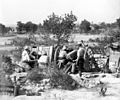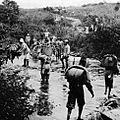Allied Powers of World War I facts for kids
The Allied Powers of World War I were the countries who fought against the Central Powers during World War I. The main countries in this group included the British Empire, France, the Russian Empire, the United States, Italy, and Japan. Interestingly, most of these countries would fight together again in World War II. However, Italy and Japan changed sides and fought with Germany in the second war.
Many of the Allied Powers in Europe were already friends and allies before World War I even started. For example, Serbia was an ally of Russia. Russia, in turn, was an ally of both Britain and France. The war began in 1914 when the Austro-Hungarian Empire declared war on Serbia. This event caused a chain reaction, leading many other countries to declare war on each other.
At first, the United States stayed neutral, meaning it did not pick a side. But after Germany took several actions against the US, the United States decided to join the war in 1917. They then fought alongside the Allied Powers.
Russia Leaves the War
Russia's fight against the Central Powers did not go well. Many Russian soldiers were not well-equipped or trained. A lot of Russians were killed, and problems like poverty and starvation became much worse. Many people in Russia blamed their leader, Czar Nicholas II, for these problems. Because of this, he was removed from power and sent away.
The new government, called the Russian Provisional Government, also made many Russians unhappy. This was because they promised to keep Russia fighting in the war. After a big change in Russia, a communist leader named Vladimir Lenin made a deal with Germany. He promised to stop the fighting between Russia and Germany if Germany helped him return to Russia to take over the government.
Lenin's main promise for his new communist government was "peace, land, and bread." This meant:
- No more fighting in the war.
- Land would be shared equally among all people in Russia.
- There would be plenty of food for everyone.
After the Communist Party took control of Russia, they kept their promise to Germany. Russia then stopped fighting in World War I.
Allies in World War II
In World War II, Italy joined Germany as part of the Axis Powers. This happened because Italy's leader, Benito Mussolini, had ideas similar to Nazism, which was Germany's main political belief.
Japan was also unhappy after World War I. They felt they did not gain as much as they wanted from the peace agreements. So, Japan also joined the Axis Powers. They believed this alliance would help the Japanese Empire grow faster than if they had stayed with the Allies.
Images for kids
-
The Council of Four (from left to right): David Lloyd George, Vittorio Emanuele Orlando, Georges Clemenceau and Woodrow Wilson in Versailles, 1919
-
HMS Dreadnought; agreements with Japan, France and Russia allowed Britain to focus resources during the Anglo-German naval arms race.
-
Indian soldiers of the 2nd Rajput Light Infantry on the Western Front, winter of 1914–15
-
French artillery in action near Gallipoli, 1915
-
Eleftherios Venizelos with Constantine during the Balkan Wars
-
Nicholas accepts the surrender of Scutari, April 1913; Montenegro's major gain from the Balkan War, it was relinquished several months later.
-
Military leaders of World War I: Alphonse Jacques de Dixmude (Belgium), Armando Diaz (Italy), Ferdinand Foch (France), John J. Pershing (United States), and David Beatty (United Kingdom)
-
President Raymond Poincaré and King George V, 1915
-
First Lord of the Admiralty Winston Churchill, 1914
-
Douglas Haig and Ferdinand Foch inspecting the Gordon Highlanders, 1918
See also
 In Spanish: Aliados de la Primera Guerra Mundial para niños
In Spanish: Aliados de la Primera Guerra Mundial para niños




































